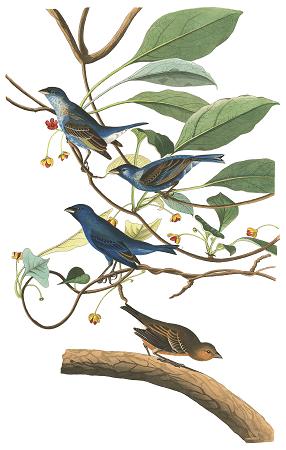
Indigo Bunting. The indigo bunting is a small seed-eating bird in the family Cardinalidae or cardinal.
It is migratory, ranging from southern Canada to northern Florida during the breeding season, and from southern Florida to northern South America during the winter. It often migrates by night, using the stars to navigate.
Its habitat is farmland, brush areas, and open woodland. The indigo bunting is closely related to the lazuli bunting and interbreeds with the species where their ranges overlap.
The indigo bunting is a small bird, with a length of 11.5-13 cm. It displays sexual dimorphism in its coloration; the male is a vibrant blue in the summer and a brown color during the winter months, while the female is brown year-round. The male displays brightly colored plumage during the breeding season to attract a mate.
Nest-building and incubation are done solely by the female. The diet of the indigo bunting consists primarily of insects during the summer months and seeds during the winter months. The indigo bunting is included in the family Cardinalidae, which is made up of passerine birds found in North and South America, and is one of seven birds in the genus Passerina. It was originally described as Tanagra cyanea by Linnaeus in his 18th-century work, Systema Naturae. The current genus name, Passerina, is derived from the Latin term passer for true sparrows and similar small birds, while the
It is migratory, ranging from southern Canada to northern Florida during the breeding season, and from southern Florida to northern South America during the winter. It often migrates by night, using the stars to navigate.
Its habitat is farmland, brush areas, and open woodland. The indigo bunting is closely related to the lazuli bunting and interbreeds with the species where their ranges overlap.
The indigo bunting is a small bird, with a length of 11.5-13 cm. It displays sexual dimorphism in its coloration; the male is a vibrant blue in the summer and a brown color during the winter months, while the female is brown year-round. The male displays brightly colored plumage during the breeding season to attract a mate.
Nest-building and incubation are done solely by the female. The diet of the indigo bunting consists primarily of insects during the summer months and seeds during the winter months. The indigo bunting is included in the family Cardinalidae, which is made up of passerine birds found in North and South America, and is one of seven birds in the genus Passerina. It was originally described as Tanagra cyanea by Linnaeus in his 18th-century work, Systema Naturae. The current genus name, Passerina, is derived from the Latin term passer for true sparrows and similar small birds, while the
Wikipedia ...